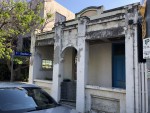Lupton
East Melbourne, Powlett Street 82, 84, 86, 88, 90, 92, 94, 96, 98, 100, 102, 104, 106, 108, 110, 112, Canterbury Terrace
A row of 16 terrace houses of five bays. The two end bays each comprising two houses and the central bay of four houses are arcaded, while the intervening bays, each of four houses, have cast iron verandahs and balconies. The terrace is often described as the longest in Melbourne.
Charles Butler gave notice of his intention to build on three dates in 1877. The first was 9 February 1877 for six 2 storey houses, the second was 24 April for four houses and lastly 31 May for another six houses.
Jolimont, Charles Street 019, Home
This early (1870) render dwelling with parapet and vertical 4 pane windows intact was altered by the addition of a concrete verandah. However, the addition has contributed to the appearance of this building and should remain. The cyclone gate and scenic leadlight of this building (1920 section) are intact. [i-Heritage]
When Charles La Trobe, lieutenant-governor of Victoria, left Melbourne to return to England in 1854 he left his friend, Dr James Palmer, to sub-divide and sell his Jolimont estate. Palmer bought the Jolimont Square section himself and subdivided the rest of the land around the periphery of estate for sale to individual buyers. The section in the middle of the estate which was occupi

